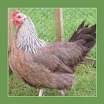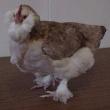‘a breed is a group of related chickens having the same general size, shape, and carriage………All the birds within a given breed share the same skin color, number of toes, and plumage style.
Skin color can be yellow – like the skin of Cornish, New Hampshires, and Wyandottes – or white – like that of Australorps, Orpingtons, and Sussex. (Note: I'll put their pics in a separate entry: this one appears to be full, or else Blogger's gone backto bed. They're gorgeous so I must get them in here!)
They may have four toes, as most breeds do, or five toes, as
 Dorkings,
Dorkings, Faverolles,
Faverolles, and Houdans do.
and Houdans do.Plumage style is more varied. Roosters are likely to have pointed neck and saddle feathers, but if they’re Sebrights (No pic- Shame.)
 or Campines, the cocks will be hen-feathered………
or Campines, the cocks will be hen-feathered……… Naked Necks have no feathers on their necks at all.
Naked Necks have no feathers on their necks at all.Other breeds have…… beards (Faverolles for example)……

boots (Brahmas),

puffy top knots (Polish),
 or long flowing tails (Yokahamas).
or long flowing tails (Yokahamas)...most…have smooth, satinlike feathers….
 Silkies, though, ……look as if they’re covered with fur.
Silkies, though, ……look as if they’re covered with fur. The feathers of Frizzles curl at the ends, giving the birds a permed look.
The feathers of Frizzles curl at the ends, giving the birds a permed look.Breeds divide into two groups: bantam and large.
And then there are classes.
And then there are varieties.
This summer, though, I found that there are also individuals. In this case: Bess and Maggie, the two black ones, snowy-white Hayley, Bernice the classic brown hen of nursery tale (I think she's a Sussex), and the two grey ladies, Blossom and Audrey. The hombre of the gallinero was handsome Spike, and there were two young fellows – one white, one brown – first identifiable as males when their baby combs started to lengthen, and beginning to develop the colours and shapes of adult plumage as I left.
Of the girls, I soon learnt that Maggie and Blossom were fairly easy going individuals. Maggie’s plump form, glossy black feathers and general air of slightly fussy well-being made her an advert for hen happiness.
Blossom was equally plump, with grey feathers which darkened half-way down her body. At first I thought this was a tide mark – the girls absolutely adore a dust bath, and will scrape a shallow hollow in dry soil, then sit themselves down and have a really good wriggle; fluttering and fluffing to get the dust under every feather – but no, Blossom was simply a two-tone hen. She was also rather sensitive, and easily intimidated. Perhaps it was a coincidence, but early on, Blossom had suffered a common poultry suppliers’ practice; which is to ‘clip’ birds’ beaks to prevent them pecking each other – thus reducing their value – when caged in shops. Since chickens use their beaks for foraging, grooming and self-defence, this is no trivial matter, plus, as Kath pointed out, if the sellers did not put so many birds in the cages in the first place, the problem wouldn’t arise. As it was, poor Blossom did the best she could.
Audrey, (I've got a funny feeling that I've mis-remembered her name, but Audrey seems to fit.....?) the other grey was another case entirely. Beak intact, she was quite aggressive, but a good layer, though clearly short on short-term memory. Almost every day, sometime between eleven and one, an eruption of raucous squawking would tell us that, once again, an astonished Audrey had just laid the first egg in the history of the universe. Over that would come Spike’s ‘¡¡¡Quiquiriqui!!!’ (Of course you knew that a Spanish cockerel crows in español?). That was one of his girls, that was.
Hayley was the only white hen, and always looked as if she’d just staggered out of bed, with the poultry equivalent of bed hair – comb askew, wing feathers poking out at all angles, and pink skin peeking. Poor Hayley had a tragic past. Her mate had been killed by a fox about two years before, and Hayley, overwhelmed with grief, had gone into a depression which took months to lift. Chickens don’t usually mate for life – but it seems this one had. Add to this the arrival of a new cockerel and Hayley’s displacement from First Wife to the very bottom of the pecking order, and you have a very sad tale.
The other black was Bess, a vicious piece of work, jealous as hell of Hayley, and battle-scarred new leader of the peck. Bess would attack anyone, avian or human, and was I thought, a prime candidate for place of honour in a chicken casserole (too tough for a pie). Kath wasn’t having this, however, because Bess, at five years old, and still laying, was an aging queen who was only doing what she had to do to preserve her place – in the pecking order.
And then there was Bernice, contented and healthy, but somehow always somewhere else when there was fresh mash, or summer treats like watermelon or almond on offer. Apparently, Bernice was just a bit….thick…
So those were the girls. The young fellows were too young to have developed much personality when I was there, and as soon as they did, would have to move on. This was Spike’s territory. Actually, I think there were plans afoot as I left to take the young white cockerel, and a maturing male pigeon too, down to the coast, where their own personal harems were waiting for them. Kath had some concerns about how the young pigeon would cope with four or six ladies requiring his services, but Andy seemed to think that he’d be fine. Sometimes you need a male perspective. ¿Si?
As for Señor Spike, he was a handsome fellow, and really looked after his girls.
Por ejemplo, one afternoon we’d been shelling nueces y almendras - walnuts and almonds - sitting on blankets in the relative cool of the stonewalled millhouse, smacking each nut smartly on its seam with a hammer so that – after some practice! – most fell smartly open.
The whole almonds were set aside for Andy’s more-ish albóndigas con salsa de almendras - meatballs with almond sauce (This is not his recipe, if you're reading, Habibi or HMHB, but you'll get the idea.) – and Kath’s yummy orange and almond fudge cake, and sensational chocolate almond cake made entirely with ground almonds instead of flour……. Ooooh get me on the next plane to Granada……
The not-entirely-crushed walnuts - (Just try dislodging the two perfect halves of a walnut from that perfectly sculpted case! Sheesh! Habibi says that the big commercial walnut growers send their crops to China, where people open each nut individually, with a hammer, because that is the most efficient way to extract the halves intact. Think about that next time you’re in the fruit and nut section of the supermarket!) - er - (Where was I? Oh yeah - the walnuts!) .....were saved for – um - really good food made with walnuts….
And the broken almonds – getting back to Señor Spike – were set aside for the chickens.
The first time I took a handful out to where the birds were going about their business, I rather nervously extended a couple of bits towards Spike on a flat palm, while keeping a wary eye on Bess, who was quickest to appreciate that something was on offer. Spike stepped forward, cocked his head, briefly examined the goods, and pecked up a piece from my hand. No pain. No blood. Of course I hadn’t really been nervous. Then he did just what Kath had said he would: dropped the treat on the ground in front of one of the girls, who promptly grabbed it. The others started crowding a little, but knew their traditions: Spike duly collected the rest of the almond pieces, and dropped some in front of each bird. He never ate a single piece until the others had had enough – not even when it was 37º and the something was ripe pear or dripping watermelon - this meant that sometimes he got nothing. I was well impressed.
Fascinating creatures, chickens.
One other thing. Kath would bring me a handful of fresh eggs whenever I ran out. (Granada's best-fed Wwoofer!) Some would be large, some medium, some small. Some brown, some pinky-beige, some white. And she could tell me which bird had laid which egg! White Hayley laid white eggs; black Maggie laid big brown ones; someone else the smaller brown; someone else the beige. Kath knew the history, personality and foibles of every one of those birds, from tender Blossom to Bess the Bitch, and loved every one. Don’t ever expect to see home-grown chicken on the table at Molino La Ratonera, but you can count on eating the very best organically produced eggs!
P.S. Ode to Bess:
Hickety, pickety, my black hen,
She lays eggs for gentlemen.
Gentlemen come every day,
To see what my black hen doth lay.
3 comments:
Mama Duck, I am reading and that recipe looks divine. I think I might do it for a starter on Thursday. I'll let you know how I get on.
I was sort of expecting this post to end with a comment about how delicious the chickens were to eat but it seems they live to peck another day!
HMHB
HMHB: Back again. The spread of photos knocked the sidebar out of alignment, but after I edited, the meter stuck at 0% publishing, and I thought I was going to lose the lot. I tried to save a draft, but the same thing happened - and yet it saved. Thank goodness! I think that the number of pictures slowed publishing right down. Just now it stuck at 0% again for two or three minutes - and then popped up again. Live and learn.
I hope you enjoy the albondigas much as we enjoyed your tandoori tikka. Yummmmmmm!
hmmmm...MamaChook just doesn't have the same ring to it! lol.
Nice story - I really enjoyed reading about the 'ens.
:-)
Post a Comment